East Hertfordshire
Explore hidden histories, historic photos, and things you never knew about East Hertfordshire from the collections and archives of Historic England.
Discover your local listed buildings and places
Introducing some of East Hertfordshire's most historic sites, included in the National Heritage List for England. Some of these captions have been summarised by AI. Click through for the official List entry. Skip this section and go to place by numbers
Benington Lordship
Benington
Benington Lordship, built on an Elizabethan farmhouse site, is a historically rich country house with gardens and park, showcasing architectural evolution and influential owners'...
Panshanger
Hertford
Panshanger Park was designed by Humphry Repton around 1806, featuring a Gothic-style house and extensive gardens. The estate evolved from earlier designs by Lancelot Brown.
The Garden House, Cottered
Cottered
Herbert Goode's early 20th-century Japanese Garden in Cottered was designed with Seyomon Kusumoto's help, featuring ponds, hills, and imported Japanese elements, now split in ownership.
Balls Park
Hertford
Balls Park features a 17th-century house by Sir John Harrison, surrounded by formal gardens and parkland, with historical enhancements in the early 18th and 20th centuries.
Baroque garden in Grotto Wood
Hertingfordbury
The Baroque garden in Grotto Wood is a rare, well-preserved post-medieval formal garden that provides insights into the merchant class and religious minorities of 18th-century society.
Hertford Castle: a motte and bailey castle south of the R…
Hertford
Hertford Castle, a well-preserved motte and bailey structure, highlights the Norman impact on medieval Britain, serving as a royal residence and key fortification from the 11th century...
Youngsbury
Thundridge
Youngsbury, designed by Lancelot "Capability" Brown in the 1760s, features picturesque grounds with enhanced landscapes, a Palladian mansion, and strategic tree planting.
Church of St Peter
Tewin
The Church of St. Peter in Tewin has 11th-century origins, with significant additions and restorations through the 13th to 20th centuries.
Tewin Water
Tewin
Tewin Water features late 18th-century landscapes by Humphry Repton around a rebuilt Neo-Classical country house. It includes designs emphasizing water features and extensive grounds.
Thundridgebury moated enclosure and associated remains of…
Thundridge
The moated enclosure, spanning 2.8ha, includes Thundridgebury House and the adjacent 15th-century church's remains, emphasizing wealth and status in the medieval period.
Poles Park
Thundridge
Poles Park, a late 19th-century country estate, was developed by the Hanburys with gardens, parkland, and Elizabethan-style architecture. It was later converted into a hotel.
Fanhams Hall
Thundridge
Fanhams Hall, built in 1715, features Edwardian gardens and a Japanese garden created by Professor Suzuki. It is now used for staff training.
Hunsdon World War II airfield defences
Eastwick
Hunsdon airfield features well-preserved World War II defense structures, including rare pillboxes and Battle Headquarters, highlighting its strategic importance in airfield protection.
Clarkson Monument on High Cross Hill
Thundridge
Commemorative monument, standing on the west side of Cambridge Road. Erected 9 October 1879 for Arthur Giles Puller of Youngsbury. The monument lies on the west side of High Cross Hill.
Pishiobury
Sawbridgeworth
Pishiobury is a historic estate with ties to Lancelot Brown and Inigo Jones. Its 2.5-storey Gothic Revival house overlooks the River Stort, surrounded by landscaped gardens.
Hunsdon Brook Fishponds
Hunsdon
A group of four Tudor fishponds, created for Henry VIII between 1525 and 1534.
Barrow Hill: a motte castle 250m south of Barrow Farm
Widford
Motte castles, like Barrow Hill, were strategic Norman fortifications vital for military and administrative purposes.
Section of Roman road in Rigery Lane
Standon
Roman roads facilitated administration and communication in Britain, serving primarily the Imperial mail service, and remain key examples of Roman civil engineering.
Rye House moated enclosure and gatehouse
Stanstead Abbots
Rye House moated enclosure is one of Hertfordshire's finest medieval sites, featuring a well-preserved 16th-century gatehouse and potential for preserving original castle remains.
RAF Sawbridgeworth World War II airfield defences
High Wych
RAF Sawbridgeworth features rare World War II structures like fighter pens and pillboxes, illustrating defensive strategies against airfield attacks.
Amwell Grove and Amwell Pool
Great Amwell
Amwell Grove and Pool, designed by architect Robert Mylne as a late 18th-century retirement residence, feature landscaped grounds with monuments to Sir Hugh Myddleton and the Mylne family.
Bowl barrow in Easneye Wood, 110m south-east of Dairy Farm
Stanstead Abbots
The Easneye Wood bowl barrow, dating from 2400-1500 BC, is a well-preserved funerary monument providing insights into prehistoric social practices in lowland Britain.
Waytemore Castle: a motte and bailey castle immediately s…
Bishop's Stortford
Waytemore Castle is a Norman motte and bailey structure known for its strategic significance and connections to William I and the Bishops of London.
Gardens to Former Amwell House Including Scott's Grotto a…
Ware
Designed in the mid-18th century by Quaker John Scott, the grotto in Ware is England's largest, adorned with shells and visited by Dr Johnson, who praised it as a 'Fairy Hall.'.
The Lordship moated site, Much Hadham
Much Hadham
The Lordship moated site in Much Hadham is a well-preserved medieval moated enclosure, signifying aristocratic status with high outer banks distinctive in Hertfordshire.
Rye House Gatehouse
Stanstead Abbots
Rye House Gatehouse, associated with the 1683 Rye House Plot against Charles II, is a significant 15th-century structure now part of Lee Valley Park.
Youngsbury Roman barrows
Thundridge
Roman barrows at Youngsbury are significant burial monuments, surviving with archaeological evidence despite past excavations.
Woodhall Park
Sacombe
Woodhall Park, a late-18th-century landscape park, features formal gardens, pleasure grounds, and a historic country house, now Heathmount School.
Moated site in Mathams Wood
High Wych
Mathams Wood moated site is a well-preserved medieval monument providing insights into aristocratic life.
Parish Church of St John the Baptist (Church of England)
Cottered
Parish church. Mid C14, possibly incorporating earlier fabric, with C15, C16 and C18 alterations and additions, restored and re-seated in 1886.
59 (Salisbury House) and 59A High Street
Buntingford
Former double ended hall house, now house (number 59) and shop (number 59A).
Datchworth War Memorial
Datchworth
Datchworth war memorial was erected in 1919 and dedicated to the fallen of the First World War with later inscriptions added to commemorate those who fell in the Second World War.
Wareside War Memorial
Wareside
War memorial, unveiled c1920 and dedicated to the fallen of the First World War with later inscriptions added to commemorate those who fell in the Second World War.
War Memorial
Tewin
War memorial located in front of St Peter's Church, designed by Sir Herbert Baker and erected in 1920.
Roman Catholic Church of St Edmund of Canterbury and Engl…
Standon
Roman Catholic Church of St Edmund of Canterbury and English Martyrs, a small parish church in the Decorated Gothic Revival style, and associated lych gate, built in 1911 to designs by...
Hunsdon War Memorial
Hunsdon
A First World War memorial, unveiled 21 November 1921 with later plaque commemorating the fallen of the Second World War.
Explore more
Search for more listed placesEast Hertfordshire through time
This timeline shows the first period of use for buildings and places on the National Heritage List for England, just one of the details recorded for every list entry. Click around to see how East Hertfordshire changes over time. Skip this section and go to aerial photos
Prehistoric Before AD 43
Prehistory covers a million years of human occupation before the Roman invasion, from hunter-gatherers of several human species, including Neanderthals, to more recent herders and farmers. It was a time of developing technologies and belief systems, involving contact with and migration from Europe, all reflected in the variety of artefact and monument types characteristic of particular prehistoric periods.
Roman AD 43 to AD 410
Britain was invaded by four legions of the Roman army in AD 43, who relatively rapidly conquered England from landing points in Kent. Parts of Wales and Scotland soon followed.
Roman culture brought urbanism, monumental buildings, wide-ranging religious beliefs, writing, and strong social hierarchy. The Roman administrative system was withdrawn in AD 410.
Early medieval AD 410 to AD 1066
This period, often associated in England with Anglo-Saxons and Vikings, saw a reduction in urban living from the Roman period and increased migration from northern Europe.
Traces of this period can be found in cemeteries, particularly in artefacts and in some of the very early churches, as this period also saw the growth of Christianity in Britain.
Medieval AD 1066 to AD 1540
This period, sometimes known as the Middle Ages, began with the Norman invasion in AD 1066. It saw a significant rise in military and defensive buildings such as castles and earthworks, as well as religious houses dominating a largely agricultural landscape.
The monarchy and Church dominated the period, which also saw the break with the Roman Catholic Church and the English reformation.
Post medieval AD 1540 to AD 1901
The Post-Medieval period brought seismic changes to life in England, with religious reformation leading to the democratization of worship and the destruction of hundreds of religious houses.
In parallel, there was a huge expansion of scientific study and enlightenment that permanently altered the nation's social structure and landscape. Industrialization and mass production lead to wider global trade, emigration, and immigration.
20th century AD 1901 to AD 2000
The 20th century saw an incredible expansion of England's transport networks, with suburban growth shadowing rapid infrastructural expansion. The establishment of state schools, hospitals, and modern technical colleges, with new architectural styles, radically changed the appearance of towns and cities.
Two catastrophic world wars and the 1918 pandemic also brought unprecedented change, altering England's built environment and social structures forever.
Prehistoric Before AD 43
Prehistory covers a million years of human occupation before the Roman invasion, from hunter-gatherers of several human species, including Neanderthals, to more recent herders and farmers. It was a time of developing technologies and belief systems, involving contact with and migration from Europe, all reflected in the variety of artefact and monument types characteristic of particular prehistoric periods.
Roman AD 43 to AD 410
Britain was invaded by four legions of the Roman army in AD 43, who relatively rapidly conquered England from landing points in Kent. Parts of Wales and Scotland soon followed.
Roman culture brought urbanism, monumental buildings, wide-ranging religious beliefs, writing, and strong social hierarchy. The Roman administrative system was withdrawn in AD 410.
Early medieval AD 410 to AD 1066
This period, often associated in England with Anglo-Saxons and Vikings, saw a reduction in urban living from the Roman period and increased migration from northern Europe.
Traces of this period can be found in cemeteries, particularly in artefacts and in some of the very early churches, as this period also saw the growth of Christianity in Britain.
Medieval AD 1066 to AD 1540
This period, sometimes known as the Middle Ages, began with the Norman invasion in AD 1066. It saw a significant rise in military and defensive buildings such as castles and earthworks, as well as religious houses dominating a largely agricultural landscape.
The monarchy and Church dominated the period, which also saw the break with the Roman Catholic Church and the English reformation.
Post medieval AD 1540 to AD 1901
The Post-Medieval period brought seismic changes to life in England, with religious reformation leading to the democratization of worship and the destruction of hundreds of religious houses.
In parallel, there was a huge expansion of scientific study and enlightenment that permanently altered the nation's social structure and landscape. Industrialization and mass production lead to wider global trade, emigration, and immigration.
20th century AD 1901 to AD 2000
The 20th century saw an incredible expansion of England's transport networks, with suburban growth shadowing rapid infrastructural expansion. The establishment of state schools, hospitals, and modern technical colleges, with new architectural styles, radically changed the appearance of towns and cities.
Two catastrophic world wars and the 1918 pandemic also brought unprecedented change, altering England's built environment and social structures forever.
Aerial photos of East Hertfordshire
Aerial photography helps reveal secrets of England's changing landscapes that are impossible to see from the ground. Skip this section and go to archive images

Much Hadham
The Lordship, Much Hadham, 1947
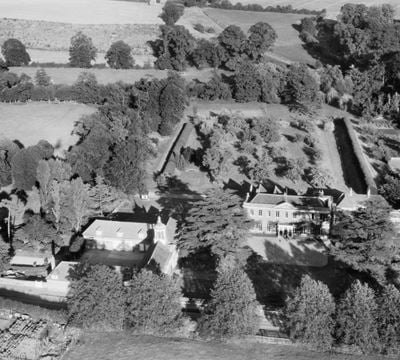
Much Hadham
The Lordship, Much Hadham, 1947
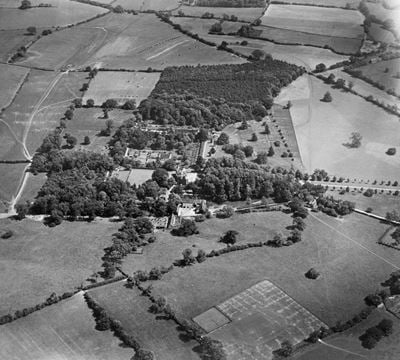
Benington
Benington Park and Home Covert, Benington, 1939
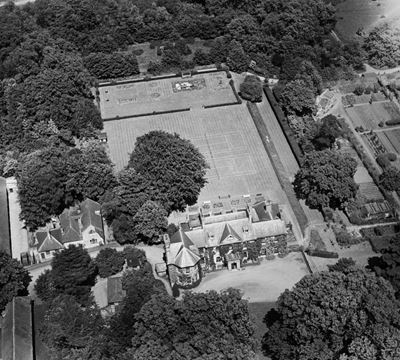
Benington
Benington Park, Benington, 1939

St Margarets
St Margaret's Bury, St Margarets, 1938
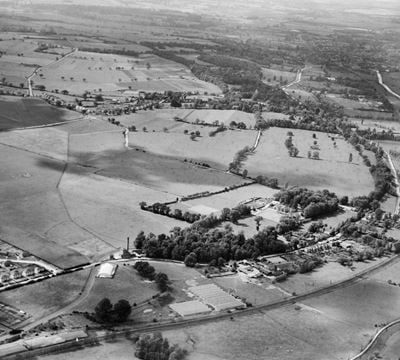
St Margarets
St Margaret's Bury and surrounding countryside, St Margarets, 1938
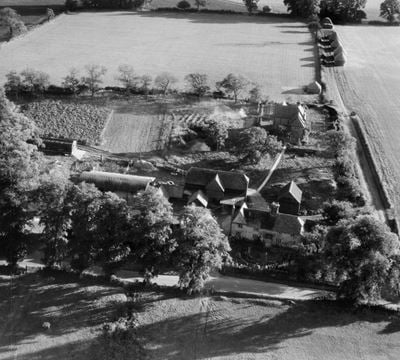
Cold Christmas
Swangles Farm, Cold Christmas, 1947
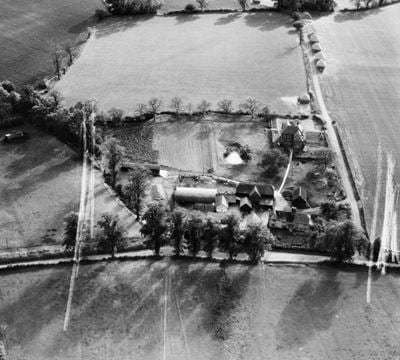
Cold Christmas
Swangles Farm, Cold Christmas, 1947

Bishop'S Stortford
Bell's Hill, Bishop's Stortford, 1920

Bishop'S Stortford
Bishop's Stortford College and environs, Bishop's Stortford, 1949
East Hertfordshire in the Historic England Archive
The Historic England Archive cares for over 15 million images, dating from the 1850s to the present day. Discover stunning images of East Hertfordshire's past. Skip this section and go to stories about heritage
Charles George Harper Collection
East Hertfordshire, Hertfordshire
Date created: 1892 - 1933
Malthouses and the tower of St Mary's Church
Eileen ‘Dusty’ Deste Collection
Great Amwell, East Hertfordshire, Hertfordshire
Date created: circa 1964
A view looking across New River towards a Weeping Willow on the opposite bank with the tower of St John the Baptist's Church in the background
Eric de Mare
Stanstead Abbots, East Hertfordshire, Hertfordshire
Date created: 1956
General view of the Maltings in Stanstead Abbots looking across the river Lee.
John Gay Collection: London
East Hertfordshire, Hertfordshire
Date created: 1960s
Looking past timber framed and rendered cottages on the Causeway towards the tower of St Mary's Church
John Gay Collection: Highgate and Hampstead
East Hertfordshire, Hertfordshire
Date created: 1973
Looking towards a junction on a village street, probably in East Hertfordshire, the surrounding buildings have rendered walls and plain tile roofs and...
John Gay Collection: Rural Life
Colliers End, East Hertfordshire, Hertfordshire
Date created: Early 1950s
A portrait of two competitors, one holding a trophy, with spectators behind at a ploughing match in Colliers End
John Gay Collection: Miscellaneous
East Hertfordshire, Hertfordshire
Date created: DEC 1960
A detail view within a domestic living room at Christmas, showing a child throwing a large round balloon into the air, with a dining table and chairs...
John Gay Collection: Counties
Ware, East Hertfordshire, Hertfordshire
Date created: 1955 - 1965
View of part of the River Lea Navigation channel in Ware, Hertfordshire, showing riverside buildings including one with a timber weatherboarded oriel...
John Laing Collection
Hunsdon, East Hertfordshire, Hertfordshire
Date created: 16 Jul 1987
D Reilly conducting the John Laing (Hendon) Ban in a marquee, during a Laing Senior Citizens Club visit to Hunsdon House
Nigel Temple Collection of Postcards of Parks and Gardens
East Hertfordshire, Hertfordshire
Date created: 1900 - 1930
VIEW SHOWING CASTLE GARDENS AND MOUND
Eric de Mare
Great Amwell, East Hertfordshire, Hertfordshire
Date created: 1945 - 1980
General view of the larger island below the church in Great Amwell with the monument to Sir Hugh Myddelton just visible.
John Laing Collection
Hunsdon, East Hertfordshire, Hertfordshire
Date created: 16 Jul 1987
Retired Laing employees dancing with partners in a marquee during a visit by the Laing Senior Citizens Club to Hunsdon House
Stories about heritage in your local area
Historic England publishes news, blogs, research, videos, and podcasts celebrating England's rich heritage. Discover the stories we have about East Hertfordshire. Skip this section and go to education
Grant to Rescue Historic Thundridge Church in Hertfordshire
Mentions Remains of Old Church of St Mary and All Saints
Historic England has awarded £72,533 in grant funding for essential works to the Old Church of St Mary and All Saints in Thundridge, Hertfordshire.
An Introduction to Artist Henry Moore
Mentions Hoglands
From Yorkshire miner’s son to world-famous artist who revolutionised sculpture in the 20th century.
Women Architects Who Helped Shape England
Mentions 102, Orchard Road
Women have always influenced domestic design but it wasn’t until 1898 that the first female architect was admitted to the Royal Institute of British...
An Introduction to Quaker Meeting Houses
Mentions Hertford Quaker Meeting House
The earliest Quaker meeting houses were distinctive for their simple, functional design; built by local craftsmen, they sit modestly in the landscape.
9 Places That Tell the Story of Early Flight
Mentions The Balloon Stone (Lunardi Monument)
The first sustained, powered, heavier-than-air flight in the UK signalled a new age of sky-high ambitions.
Grant to Rescue Historic Thundridge Church in Hertfordshire
Mentions Remains of Old Church of St Mary and All Saints
Historic England has awarded £72,533 in grant funding for essential works to the Old Church of St Mary and All Saints in Thundridge, Hertfordshire.
War Memorials Listed in the East of England
Mentions Hertford Heath War Memorial
4 First World War memorials in Cambridgeshire and Hertfordshire have been listed at Grade II by DCMS on the advice of Historic England.
War Memorials Listed Ahead of Armistice Day
Mentions War Memorial at St Michael's Church, Hunsdon War Memorial, East Hertfordshire
First World War memorials in England have been listed ahead of Armistice Day. Many of them also commemorate those lost during the Second World War.
Quiet Simplicity of Quaker Meeting Houses Celebrated
Mentions Hertford Quaker Meeting House
17 Quaker meeting houses across England listed or upgraded.
National Collection of Sir Herbert Baker’s War Memorials Recognised
Mentions War Memorial, War Memorial, Main Quadrangle and Memorial Hall Attached, at Haileybury and Imperial Service College
15 First World War memorials by Sir Herbert Baker have been listed or upgraded to commemorate the centenary of the Commonwealth War Graves Commission.
East Hertfordshire's social history through photos
Over 10,000 images from the Historic England Archive have been specially selected and re-captioned for teachers, students, and anyone who wants to learn more about their local area. Skip this section and go to grant-aided places
Young girl kneeling on roadside
Period: 1950s (1950 - 1959)
Portrait of a girl holding a bunch of cowslips, kneeling on a roadside in East Hertfordshire
Young girl kneeling on roadside
Widford School, Ware Road, Widford, Hertfordshire
Period: Victorian (1837 - 1901)
This school was built in 1875-6. After the 1870 Education Act the small school from 1829 was considered to be "altogether unsuitable".
Widford School, Ware Road, Widford, Hertfordshire
Waytemore Castle, The Causeway, Bishops Stortford, Hertfordshire
Period: Medieval (Middle Ages) (1066 - 1484)
These are the remains of a late 11th century motte and bailey castle. It is north of the town on the east bank of the River Stort.
Waytemore Castle, The Causeway, Bishops Stortford, Hertfordshire
Ware, Hertfordshire
Period: 1960s (1960 - 1969)
View of an industrial river barge loaded with timber planks, moored on the RIver Lea Navigation channel in Ware, Hertfordshire, with riverside...
Ware, Hertfordshire
US servicemen at a ploughing match, Colliers End, Hertfordshire
Period: 1950s (1950 - 1959)
United States servicemen at a ploughing match in Colliers End.
US servicemen at a ploughing match, Colliers End, Hertfordshire
The Town House, Baldock Road, Cottered, Hertfordshire
Period: Georgian (1714 - 1836)
This block of 3 almshouses was built in 1767. They were built for Rev. Angel Chauncy.
The Town House, Baldock Road, Cottered, Hertfordshire
Tags
The Salisbury Arms Hotel, Fore Street, Hertford
Period: Medieval (Middle Ages) (1066 - 1484)
This building was recorded as The Bell Inn in 1431 but took its present name in circa 1800 when it was purchased by the Marquess of Salisbury.
The Salisbury Arms Hotel, Fore Street, Hertford
The Priory, High Street, Ware, Hertfordshire
Period: Medieval (Middle Ages) (1066 - 1484)
The name Priory is incorrect, it was originally a Friary. The building includes the remains of a Franciscan house (friary).
The Priory, High Street, Ware, Hertfordshire
Discover more
Ready for more local stories? Take a look at these other places nearby


